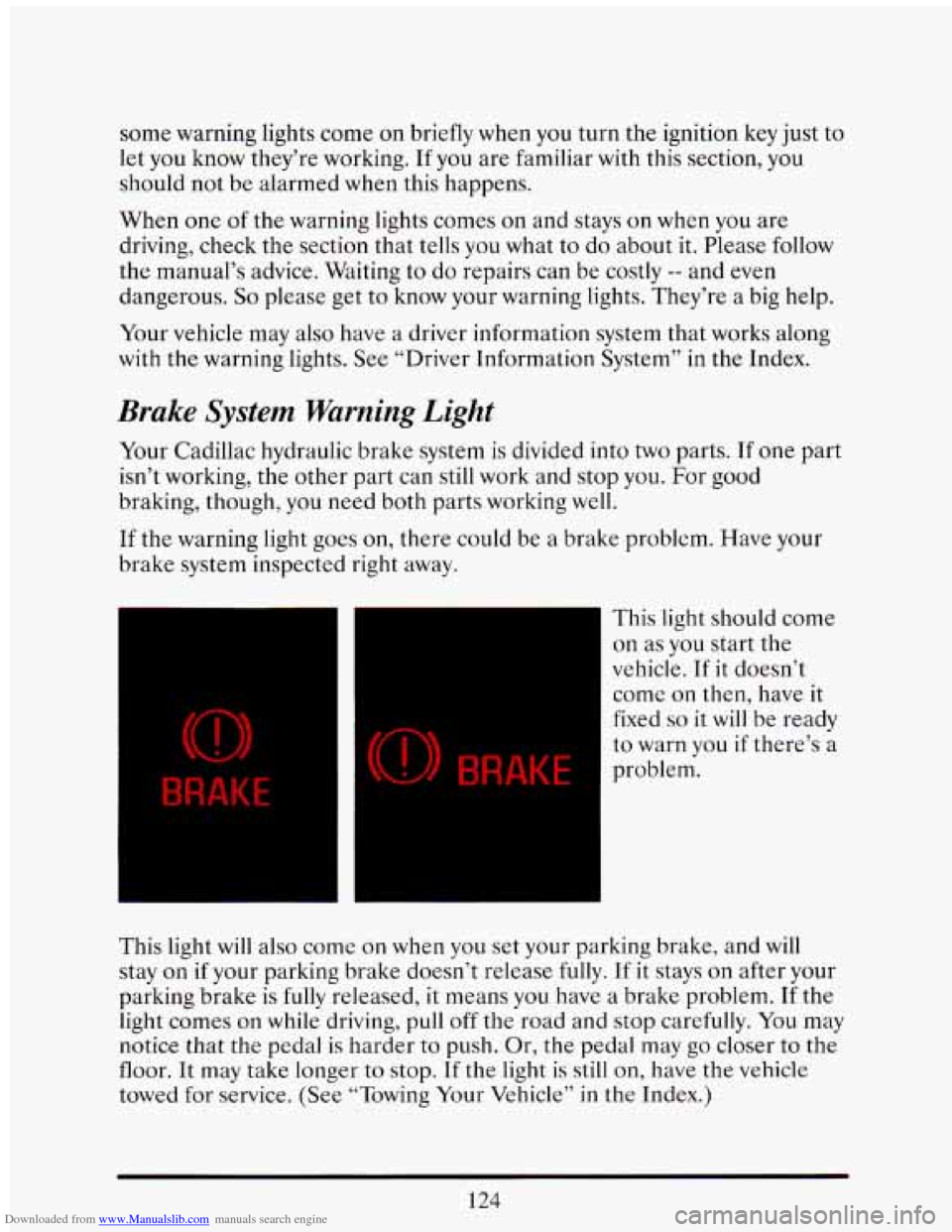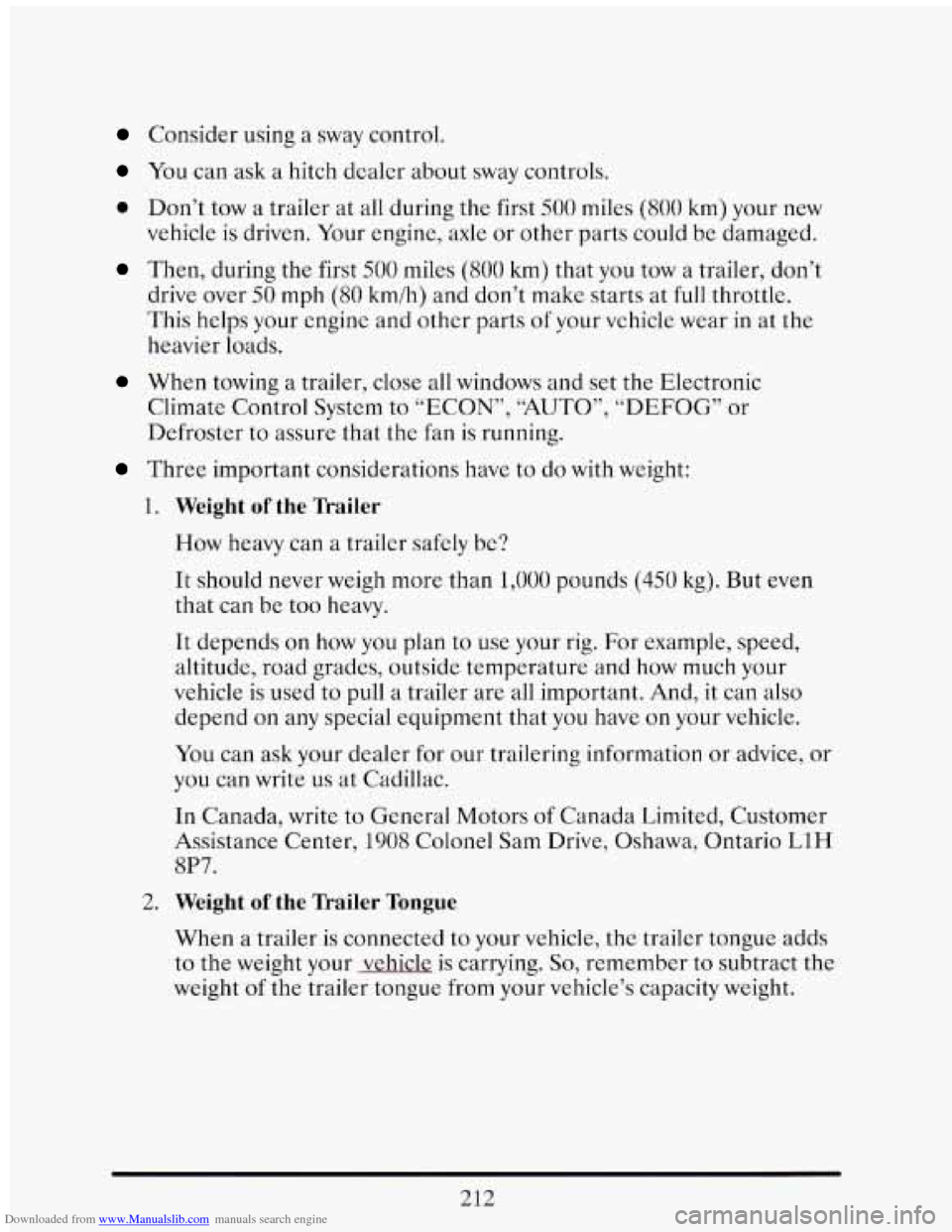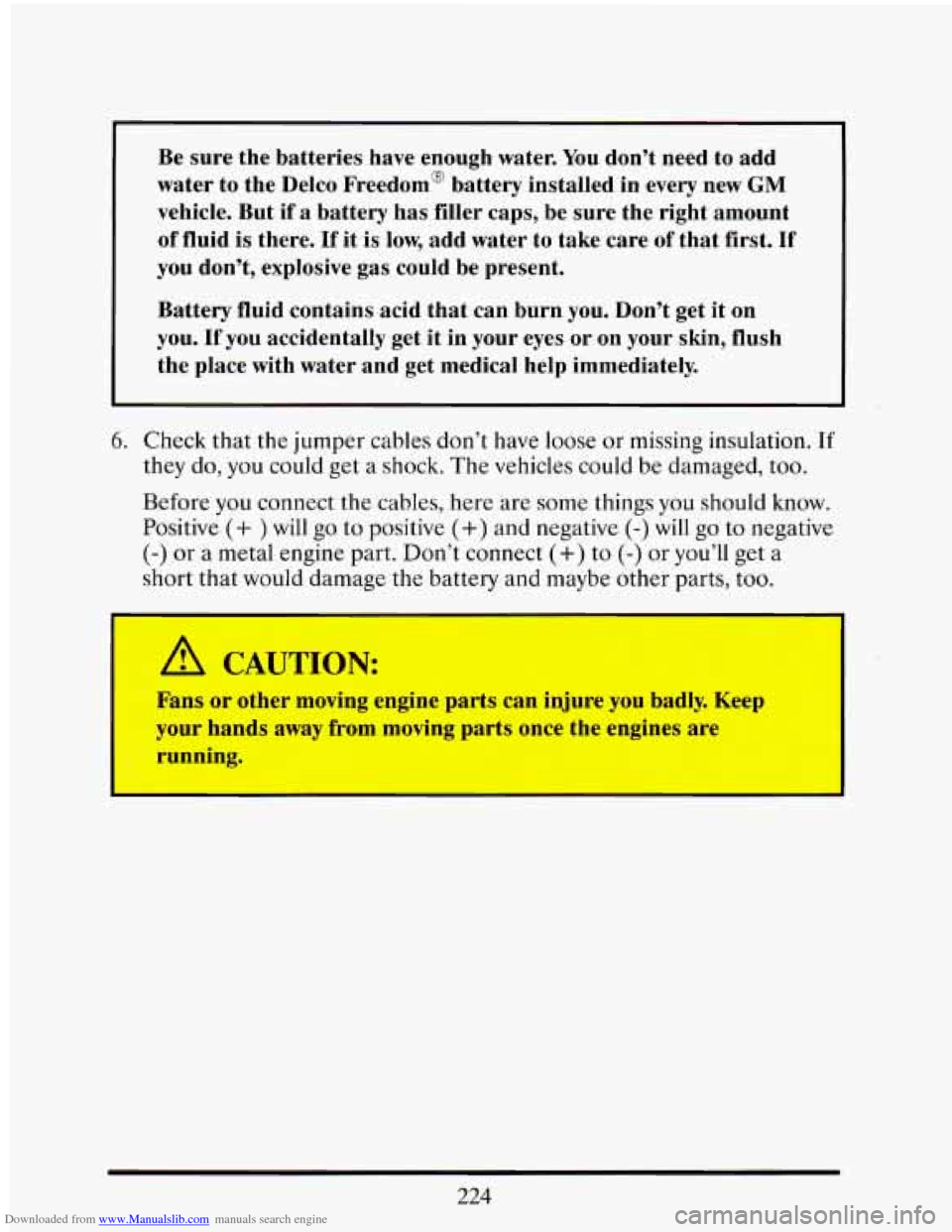Page 104 of 398
Downloaded from www.Manualslib.com manuals search engine PARKlING OVER THINGS TlYAT BURN
A CAUTION:
Things that can burn could touch hot exhaust parts under your
vehicle and ignite. Don't park over papers, leaves, dry grass or
other things that can burn.
90
Page 138 of 398

Downloaded from www.Manualslib.com manuals search engine some warning lights come on briefly when you turn the ignition key just to
let you know they’re working.
If you are familiar with this section, you
should not be alarmed when this happens.
When one
of the warning lights comes on and stays on when you are
driving, check the section that tells you what to do about it. Please follow
the manual’s advice. Waiting to do repairs can be costly
-- and even
dangerous.
So please get to know your warning lights. They’re a big help.
Your vehicle may
also have a driver information system that works along
with the warning lights. See “Driver Information System” in the Index.
Brake System Warning Light
Your Cadillac hydraulic brake system is divided into two parts. If one part
isn’t working, the other part can still work and stop you. For good
braking, though, you need both parts working
well.
If the warning light goes on, there could be a brake problem. Have your
brake system inspected right away.
BRAKE
(0) BRAKE
This light should come
on as you start the
vehicle. If it doesn’t
come
on then, have it
fixed
so it will be ready
to warn you if there’s a
problem.
This light will also come
on when you set your parking brake, and will
stay
on if your parking brake doesn’t release fully. If it stays on after your
parking brake
is fully released, it means you have a brake problem. If the
light comes
on while driving, pull off the road and stop carefully. You may
notice that the pedal is harder
to push. Or, the pedal may go closer to the
floor. It may take longer to stop.
If the light is still on, have the vehicle
towed for service. (See “Towing Your Vehicle” in
the Index.)
124
Page 216 of 398

Downloaded from www.Manualslib.com manuals search engine If you drive regularly in steep country, or if you’re planning to visit there,
here are some tips that can
make your trips safer and more enjoyable.
0 Keep your vehicle in good shape. Check all fluid levels and also the
brakes, tires, cooling system and transaxle. These parts can work hard
on mountain roads.
Know how to go down hills. The most important thing to know is this:
let your engine do some
of the slowing down. Don’t make your brakes
do it all. Shift to a lower gear when you go down a steep or long hill.
That way, you
will slow down without excessive use of your brakes.
<
A CAUTION: .r S<*.
If you don’t shift down, your brakes could get so hot that they ’+--*
wouldn’t work well. You would then have poor braking or even
none going down
a hill. You could crash. Shift down to let your
engine assist your brakes on
a stef downhil’ lope.
- - i. .*$
Coasting downhill in “N” (Neutral) or with the ignition off is
dangerous. Your brakes will have to do all the work of slowing
down. They could get
so hot that they wouldn’t work well. You
could crash. Always have your engine running and your vehicle
in gear when you
go downhill.
0 Know how to go uphill. You may want to shift down to a lower gear.
The lower gears help cool your engine and transaxle, and you can
climb the hill better.
Stay in your own lane when driving on two-lane roads in hills or
mountains. Don’t swing wide or cut across the center
of the road.
Drive at speeds that let you stay
in your own lane. That way, you won’t
be surprised by a vehicle coming toward
you in the same lane.
202
Page 226 of 398

Downloaded from www.Manualslib.com manuals search engine Consider using a sway control.
You can ask a hitch dealer about sway controls.
0 Don’t tow a trailer at all during the first 500 miles (800 km) your new
vehicle is driven. Your engine, axle or other parts could be damaged.
Then, during the first 500 miles (800 km) that you tow a trailer, don’t
drive over 50 mph (80 kmih) and don’t make starts at full throttle.
This helps your engine and other parts
of your vehicle wear in at the
heavier loads.
When towing a trailer, close all windows and set the Electronic
Climate Control System
to “ECON”, “AUTO”, “DEFOG” or
Defroster to assure that the fan is running.
Three important considerations have to do with weight:
1. Weight of the nailer
How heavy can a trailer safely be?
It should never weigh more than 1,000 pounds (450 kg). But even
that can be too heavy.
It depends on how you plan to use your rig. For example, speed,
altitude, road grades, outside temperature and how much your
vehicle
is used to pull a trailer are all important. And, it can also
depend on any special equipment that you have on your vehicle.
You can ask your dealer for our trailering information or advice, or
you can write
us at Cadillac.
In Canada, write to General Motors of Canada Limited, Customer
Assistance Center,
1908 Colonel Sam Drive, Oshawa, Ontario L1H
8P7.
2. Weight of the Trailer Tongue
When a trailer is connected to your vehicle, the trailer tongue adds
to the weight your vehicle is carrying.
So, remember to subtract the
weight of the trailer tongue from your vehicle’s capacity weight.
212
Page 238 of 398

Downloaded from www.Manualslib.com manuals search engine Be sure the batteries have enough water. You don’t need to add
water to the Delco Freedoma battery installed in every new GM
vehicle. But if a battery has filler caps, be sure the right amount
of fluid is there. If it is low, add water to take care of that first. If
you don’t, explosive gas could be present.
Battery fluid contains acid that can burn you. Don’t get it
on
you. If you accidentally get it in your eyes or on your skin, flush
the place with water and get medical help immediately.
6. Check that the jumper cables don’t have loose or missing insulation. If
they do, you could get a shock. The vehicles could be damaged, too.
Before
you connect the cables, here are some things you should know.
Positive (+ ) will go to positive (+) and negative (-) will go to negative
(-) or a metal engine part. Don’t connect (+) to (-) or you’ll get a
s.hort th,g$ w.Quld damage the battery and maybe other parts, too.
A CAUTION:
Fans or other moving engine parts can injure you badly. Keep
your hands a1
- rom moving 1 -ts once the engines are
running.
224
Page 240 of 398
Downloaded from www.Manualslib.com manuals search engine neavy unpainted metal part on the engine of the vehicle with the dead
battery.
Attach the cable at least
18 inches (45 cm) away from the dead
battery, but not near engine parts that move. The electrical connection
is just as good there, but the chance of sparks getting back to the
battery
is much less.
4.9 Liter
4.6 Liter (Northstar)
11. Now start the vehicle with the good battery and run the engine for
12. Try to start the vehicle with the dead battery.
awhile.
226
Page 243 of 398

Downloaded from www.Manualslib.com manuals search engine r
I
I
r- 1-
i-
i-
1
A CAUTION:
To help avoid injury to you or others:
0
0
0
0
0
0
Never let passengers ride in a vehicle that is being towed.
Never tow faster than safe or posted speeds.
Never tow with damaged parts not fully secured.
Never get under your vehicle after it has been lifted by the
tow truck.
Always use separate safety chains on each side when towing a
vehicle.
Never use
“J” hooks. Use T-hooks instead.
When your vehicle is being towed, have the ignition key off. The steering
wheel should be clamped in
a straight-ahead position, with a clamping
device designed for towing service.
Do not use the vehicle’s steering
column lock for this. The transaxle should be in Neutral and the parking
-
F brake released.
Don’t have your vehicle towed on the front wheels, unless you must.
If
the vehicle must be towed on the front wheels, don’t go more than 55
mph (88 km/h) or farther than 500 miles (804 lun) or your transaxle will
be damaged.
If these limits must be exceeded, then the front wheels have
to. be supported on a dolly.
c
m
IC
229
Page 247 of 398
Downloaded from www.Manualslib.com manuals search engine I
A CAUTION:
An electric fan under the hood can start up even when the
engine is not running and can injure you. Keep hands, clothing
and tools
away from any underhood electric fan.
If the coolant inside the coolant recovery tank is boiling, don’t do
anything else until it cools down.
The coolant level should be at or above
“FULL COLD.” If it isn’t, you
may have
a leak in the radiator hoses, heater hoses, radiator, water pump
or somewhere else
in the cooling system.
I
Heater and radiator hoses, and other engine parts, can be very
hot. Don’t touch them. If you do, you can be burned.
Don’t run the engine if there is
a leak. If you run the engine, it
z;:s- could lose all coolant. That could cause an engine fire, and you
%-?7 ..- I could be burned. Get any leak fixed before you drive the vehicle.
2 . Y -- I
-
- .:.- .. .
.-I. * .C, . --
233